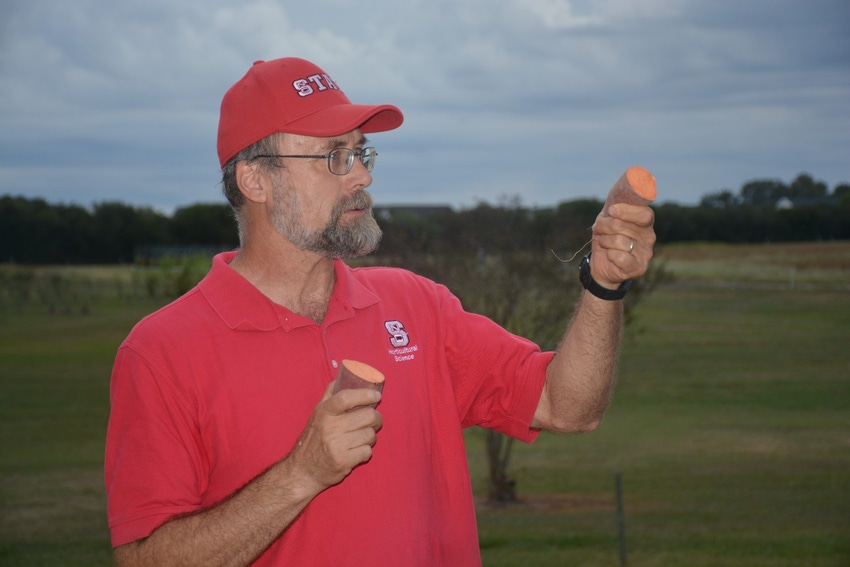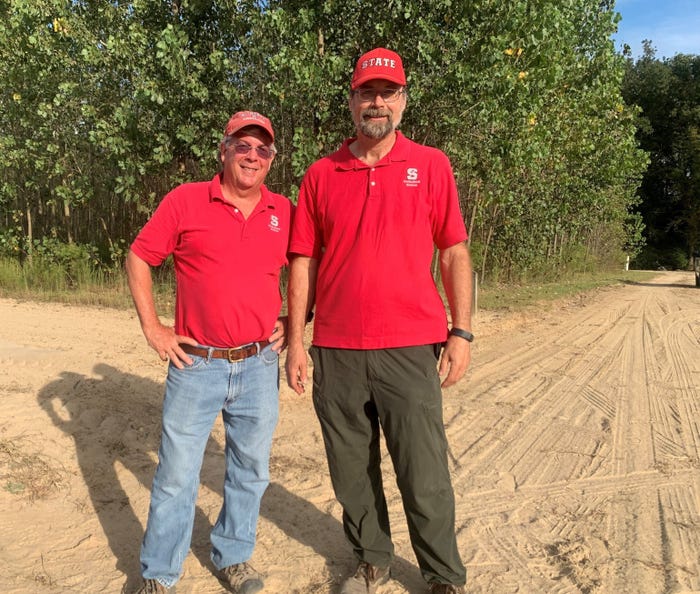
As the market for purple sweet potatoes expands, North Carolina State University’s breeding program will continue to develop varieties for farmers that will meet the demand and perform well on the farm.
At the North Carolina Sweet potato Field Day held Oct. 5 at the NCDA&CS Horticultural Crops Research Station in Clinton, North Carolina State sweetpotato breeder Ken Pecota debuted two new purple varieties — Purple Splendor and Purple Majesty — that are now available for growers who want to try their hand at growing purple sweet potatoes in addition to the more well-known orange varieties.
Also, at the field day, Pecota and Craig Yencho, leader of the Sweetpotato and Potato Breeding and Genetics Programs at North Carolina State highlighted additional breeding efforts to develop new orange sweet potato varieties that meet the demands of packers and processors, and also offer disease resistance and yield potential to growers. High on the list is developing new varieties that are tolerant to the troublesome guava root knot nematode.
As for purple sweet potatoes, Pecota said purples aren’t the primary focus of the breeding work, but the program did want to release varieties that will give North Carolina sweet potato farmers an advantage if the market for purple sweet potatoes can be developed.
Yencho urged farmers who want to try purple sweet potatoes in a small way to contact him or Pecota to learn more. Purple Splendor and Purple Majesty are currently available for farmers to plant on a small scale.
See where purple market lies
“We are trying to see where the market lies with these new purples. We are seeking plant patent status and to license them. These varieties are a substantial step up from Stokes Purple,” Yencho said, referring to the purple variety that is now grown by a small group of sweetpotato farmers, mostly in California, under specific licensing conditions.
Pecota said Purple Splendor is a very controlled shape sweet potato that offers a decent disease resistance package. He says it provides good Fusarium resistance, and good Southern root knot (Meloidogyne incognita) resistance. Yields are on par with Covington, the most popular orange sweet potato grown in North Carolina. However, Pecota cautioned that Purple Splendor will have some veins under severe stress.
“Probably my biggest concern with this line is that it produces a lot of plants in the beds, and it’s very hard not to bed them too dense. If they grow too dense, they become very susceptible to Southern blight. This is real problem in dense beds. Space it out twice as far as you think possible,” Pecota said.
The other new purple sweet potato variety, Purple Majesty, offers the classic sweet potato shape. Pecota said it has a good pigment and yields equal to Covington. It is a high starch sweet potato and also contains a bit of beta-carotene as well.
“The disease package is not quite as good as Purple Splendor. It doesn’t have M. incognita resistance. It does have good Fusarium resistance. Neither of these varieties (Purple Splendor and Purple Majesty) have Streptomyces resistance so you will have to watch that,” Pecota said.

The new purple splendor sweetpotato variety released by the North Carolina State University breeding program. (NCSU Photo)
“One big limitation on Purple Splendor is it can’t swim. In flooded areas, it’s gone. This one should not be planted on bottoms or heavy fields. Plant it on well drained soils to keep it dry and it will be okay,” he said.
Purple Splendor does provide fantastic plant production and big sturdy plants. Pecota said the plants are big, thick, sturdy and uniform, like little trees. “I wish all of our plant beds could look like this. It’s just a joy to cut. Part of the big yield is because of the big strong plants it produces. Purple Splendor is one of the best plant producers we’ve ever seen. We are using it in the orange nursery to give them those high-quality traits.”
Orange varieties driving force
While Pecota, Yencho and their team are working on breeding additional purple sweet potato lines, orange varieties remain the driving force of their work. Pecota highlighted NC17-0439, an experimental line that may be released commercially in three years if it continues to perform well.
Pecota said NC17-0439 offers a good disease package and provides some of the best resistance to Fusarium that his team has ever seen. It also offers good Streptomyces resistance, comes in a good shape with good skin quality and stores better than the varieties Beauregard and Covington.
“It makes a good quality fry, and it has nice baking quality. I like the tubular shape. That’s where we are heading for processing types. It provides good recovery on the French fry slice line,” he said.
Meanwhile, Yencho emphasized that more than 60% of North Carolina State’s sweet potato breeding work is now focused on developing varieties that are resistant to the guava root knot nematode.
“We’ve found some good genes. We think we are going to have some molecular markers for it. We are pushing it very hard. We are encouraged by what we see, but it’s going to be a long journey. I think there are going to be cultural management aspects. The cultural side is your solution to guava root knot nematode right now,” Yencho says.
It will likely take from three to six years for a guava root knot nematode variety to be commercially available to sweetpotato growers. “If we get lucky, maybe we come up with something quicker, but I think that’s a reasonable time horizon for us,’ Yencho said.
Key: Finding good parents
The key to breeding for guava root knot resistance is to find guava root knot resistant parents. “The way its heritability works is you get all of it or none of it. The resistance we have seen so far appears to be conferred by a single dominant gene and you either have resistance or you don’t have resistance. We are screening large quantities of lines that have resistant parents. We are screening those to find ones that are better,” Pecota said.
Three of the lines Pecota is looking at come from the old variety Centennial which is resistant to guava root knot nematodes. Pecota explained that many of the earliest sweet potato varieties grown in the United States in the 1800s were resistant to guava root knot nematode. “Breeders turned away from using the older varieties, using new ones with better horticultural traits, but many of these turned out not to have guava root knot nematode resistance.”
Now, the breeding program is turning to Centennial and some of the older varieties to find guava root knot nematode resistant genes. The problem with Centennial, Pecota says,” is that it does not have a good disease resistance package and does not perform under flooded conditions.
Additionally, North Carolina State is turning to germplasm from Louisiana State University to find guava root knot resistance. “We are working with LSU to bring in material that has guava resistance and incognita resistance.
As for managing guava root knot nematodes in sweet potatoes, Pecota emphasized that developing resistant varieties won’t be a cure all. Chemical control, cultural practices and avoiding fields with a history of guava root knot nematode resistance will continue to be critical.
“We don’t know how good that genetic resistance is yet in terms of control. We know it’s not going to be your sole management strategy. You’re still going to need to rotate, you still need to avoid those fields with a history of root knot nematodes as much as possible. We’re hoping from this background to get the whole package of resistance,” Pecota said.

Craig Yencho, left, leader of the Sweetpotato and Potato Breeding and Genetics Programs at North Carolina State University, and North Carolina State University sweetpotato breeder Ken Pecota.(NCSU Photo)
About the Author(s)
You May Also Like






